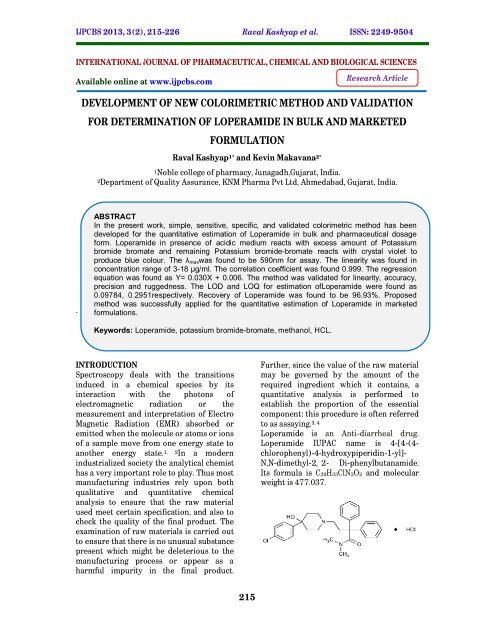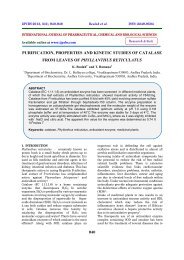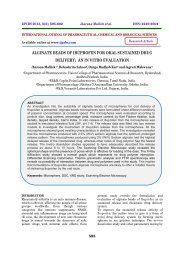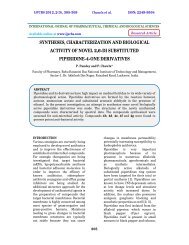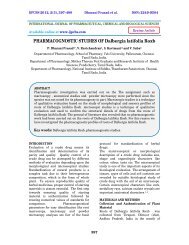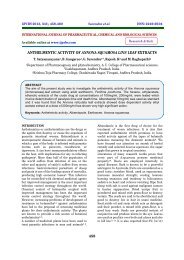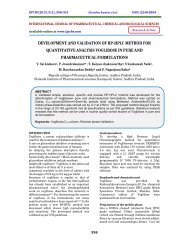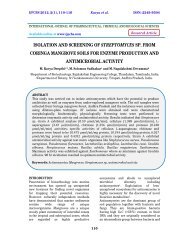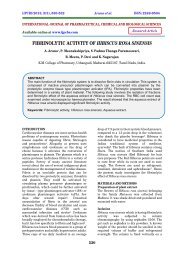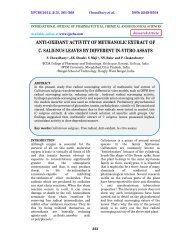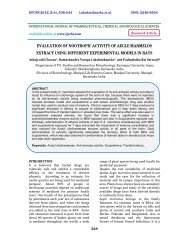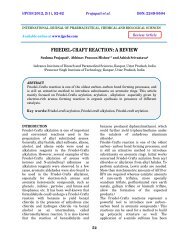development of new colorimetric method and validation for ... - ijpcbs
development of new colorimetric method and validation for ... - ijpcbs
development of new colorimetric method and validation for ... - ijpcbs
Create successful ePaper yourself
Turn your PDF publications into a flip-book with our unique Google optimized e-Paper software.
IJPCBS 2013, 3(2), 215-226 Raval Kashyap et al. ISSN: 2249-9504<br />
INTERNATIONAL JOURNAL OF PHARMACEUTICAL, CHEMICAL AND BIOLOGICAL SCIENCES<br />
Available online at www.<strong>ijpcbs</strong>.com<br />
Research Article<br />
DEVELOPMENT OF NEW COLORIMETRIC METHOD AND VALIDATION<br />
FOR DETERMINATION OF LOPERAMIDE IN BULK AND MARKETED<br />
FORMULATION<br />
Raval Kashyap 1* <strong>and</strong> Kevin Makavana 2*<br />
1Noble college <strong>of</strong> pharmacy, Junagadh,Gujarat, India.<br />
2Department <strong>of</strong> Quality Assurance, KNM Pharma Pvt Ltd, Ahmedabad, Gujarat, India.<br />
.<br />
ABSTRACT<br />
In the present work, simple, sensitive, specific, <strong>and</strong> validated <strong>colorimetric</strong> <strong>method</strong> has been<br />
developed <strong>for</strong> the quantitative estimation <strong>of</strong> Loperamide in bulk <strong>and</strong> pharmaceutical dosage<br />
<strong>for</strong>m. Loperamide in presence <strong>of</strong> acidic medium reacts with excess amount <strong>of</strong> Potassium<br />
bromide bromate <strong>and</strong> remaining Potassium bromide-bromate reacts with crystal violet to<br />
produce blue colour. The λ max was found to be 590nm <strong>for</strong> assay. The linearity was found in<br />
concentration range <strong>of</strong> 3-18 µg/ml. The correlation coefficient was found 0.999. The regression<br />
equation was found as Y= 0.030X + 0.006. The <strong>method</strong> was validated <strong>for</strong> linearity, accuracy,<br />
precision <strong>and</strong> ruggedness. The LOD <strong>and</strong> LOQ <strong>for</strong> estimation <strong>of</strong>Loperamide were found as<br />
0.09784, 0.2951respectively. Recovery <strong>of</strong> Loperamide was found to be 96.93%. Proposed<br />
<strong>method</strong> was successfully applied <strong>for</strong> the quantitative estimation <strong>of</strong> Loperamide in marketed<br />
<strong>for</strong>mulations.<br />
Keywords: Loperamide, potassium bromide-bromate, methanol, HCL.<br />
INTRODUCTION<br />
Spectroscopy deals with the transitions<br />
induced in a chemical species by its<br />
interaction with the photons <strong>of</strong><br />
electromagnetic radiation or the<br />
measurement <strong>and</strong> interpretation <strong>of</strong> Electro<br />
Magnetic Radiation (EMR) absorbed or<br />
emitted when the molecule or atoms or ions<br />
<strong>of</strong> a sample move from one energy state to<br />
another energy state. 1, 2 In a modern<br />
industrialized society the analytical chemist<br />
has a very important role to play. Thus most<br />
manufacturing industries rely upon both<br />
qualitative <strong>and</strong> quantitative chemical<br />
analysis to ensure that the raw material<br />
used meet certain specification, <strong>and</strong> also to<br />
check the quality <strong>of</strong> the final product. The<br />
examination <strong>of</strong> raw materials is carried out<br />
to ensure that there is no unusual substance<br />
present which might be deleterious to the<br />
manufacturing process or appear as a<br />
harmful impurity in the final product.<br />
Further, since the value <strong>of</strong> the raw material<br />
may be governed by the amount <strong>of</strong> the<br />
required ingredient which it contains, a<br />
quantitative analysis is per<strong>for</strong>med to<br />
establish the proportion <strong>of</strong> the essential<br />
component: this procedure is <strong>of</strong>ten referred<br />
to as assaying. 3, 4<br />
Loperamide is an Anti-diarrheal drug.<br />
Loperamide IUPAC name is 4-[4-(4-<br />
chlorophenyl)-4-hydroxypiperidin-1-yl]-<br />
N,N-dimethyl-2, 2- Di-phenylbutanamide.<br />
Its <strong>for</strong>mula is C29H33ClN2O2 <strong>and</strong> molecular<br />
weight is 477.037.<br />
215
IJPCBS 2013, 3(2), 215-226 Raval Kashyap et al. ISSN: 2249-9504<br />
It is soluble in methanol <strong>and</strong><br />
chlor<strong>of</strong>orm.Loperamide is a synthetic<br />
piperidine derivative, is an opioid drug<br />
effective against diarrhea resulting from<br />
gastroenteritis or inflammatory bowel<br />
disease. In most countries it is available<br />
generically <strong>and</strong> under br<strong>and</strong> names such as<br />
Lopex, Imodium, Dimor, Fortasec <strong>and</strong> Pepto<br />
Diarrhea Control. It was developed at<br />
Janssen Pharmaceutical.Loperamide is an<br />
opioid-receptor agonist <strong>and</strong> acts on the µ-<br />
opioid receptors in them enteric plexus <strong>of</strong><br />
the large intestine; by itself it does not affect<br />
the central nervous system like other<br />
opioids. It works by decreasing the activity<br />
<strong>of</strong> the my enteric plexus; Loperamide also<br />
decreases colonic mass movements <strong>and</strong><br />
suppresses the gastro colic reflex.<br />
Loperamide molecules do not cross the<br />
blood-brain barrier in significant amounts,<br />
<strong>and</strong>, thus, it has no analgesic or euphoric<br />
properties. Adverse drug reactions (ADRs)<br />
associated with Loperamide includes<br />
abdominal pain <strong>and</strong> bloating, nausea,<br />
vomiting <strong>and</strong> constipation. Rare side-effects<br />
associated with Loperamide are paralytic<br />
ileus, dizziness <strong>and</strong> rashes. 5<br />
Up to now there are many <strong>method</strong>s<br />
developed<br />
likespectr<strong>of</strong>luorimetric<br />
<strong>and</strong>Derivative<br />
absorption<br />
spectrophotometric, LC-MS spectroscopic<br />
<strong>method</strong> developed etc… 6-11 but very few<br />
<strong>method</strong>s develop on <strong>colorimetric</strong> <strong>for</strong><br />
Voriconazole. So here aim is to develop <strong>new</strong><br />
<strong>colorimetric</strong> <strong>method</strong> on Voriconazole. And<br />
<strong>validation</strong> will be done on Voriconazole. The<br />
USP has published specific guidelines <strong>for</strong><br />
<strong>method</strong> <strong>validation</strong> <strong>for</strong> compound<br />
evaluation. USP defines eight steps <strong>for</strong><br />
<strong>validation</strong>: Accuracy, Precision, Specificity,<br />
Limit <strong>of</strong> detection, <strong>and</strong> Limit <strong>of</strong> quantitation,<br />
Linearity <strong>and</strong> range, Ruggedness ,<br />
Robustness 12<br />
MATERIALS AND METHODS<br />
Loperamide was determined<br />
spectrophotometrically in bulk <strong>and</strong><br />
marketed <strong>for</strong>mulation by using Potassium<br />
bromide-bromate reagent in presence <strong>of</strong><br />
HCl <strong>and</strong> crystal violet as dye.<br />
EXPERIMENTAL<br />
a) Instrumentation: JASCO V-630 UV<br />
spectrophotometer with 1 cm path<br />
length matched glass cuvettes were<br />
used in <strong>method</strong> <strong>development</strong>.<br />
b) Preparation <strong>of</strong> st<strong>and</strong>ard stock<br />
solution <strong>of</strong> Loperamide: St<strong>and</strong>ard<br />
stock solution prepared by<br />
accurately weighing 100 mg <strong>of</strong><br />
Loperamide in 100 ml calibrated<br />
volumetric flask <strong>and</strong> made up the<br />
volume with methanol up to 100 ml.<br />
c) Preparation <strong>of</strong> working st<strong>and</strong>ard<br />
solution <strong>of</strong> Loperamide: working<br />
st<strong>and</strong>ard was prepared by<br />
transferring <strong>of</strong> 10 ml st<strong>and</strong>ard stock<br />
solution into 100 ml calibrated<br />
volumetric flask <strong>and</strong> made up the<br />
volume with methanol to get<br />
concentration <strong>of</strong> 100µg/ml.<br />
Preparation <strong>of</strong> solution<br />
a) Preparation <strong>of</strong>330µg/ml <strong>of</strong><br />
[(1:0.1)KBr:KBrO3]Potassium<br />
bromide-bromate reagent: weighed<br />
accurately 1.0 gm potassium<br />
bromide <strong>and</strong> 0.1 gm potassium<br />
bromate, transferred into 100 ml<br />
volumetric flask <strong>and</strong> made up the<br />
volume with distilled water. From<br />
that 3ml transferred in 100ml<br />
volumetric flask <strong>and</strong> made up<br />
volume up to 100ml with distilled<br />
water.<br />
b) Preparation <strong>of</strong> 2M HCl: 17ml<br />
concentrated HCl dissolved in<br />
100ml distilled water.<br />
c) Preparation <strong>of</strong> 0.025% <strong>of</strong> crystal<br />
violet: Transferred 250mg <strong>of</strong> crystal<br />
violet into 100 ml volumetric flask<br />
<strong>and</strong> made up with distilled water.<br />
From that 10ml solution transferred<br />
into 100ml volumetric flask <strong>and</strong><br />
made up with distilled water.<br />
Preliminary investigation<br />
Transferred 0.3ml <strong>of</strong> drug working<br />
st<strong>and</strong>ard solution into 10ml volumetric<br />
flask. 1 ml <strong>of</strong> 660µg/ml Potassium bromidebromate<br />
reagent <strong>and</strong> 1 ml <strong>of</strong> 1M HCl were<br />
added, kept it <strong>for</strong> 15 minutes. After that<br />
0.2ml <strong>of</strong> 0.1% crystal violet was added <strong>and</strong><br />
216
IJPCBS 2013, 3(2), 215-226 Raval Kashyap et al. ISSN: 2249-9504<br />
made up the volume with methanol.<br />
Absorbance was recorded.<br />
Parameter fixation<br />
a) Determination <strong>of</strong> absorption maxima<br />
An absorption maxima (or) max are the<br />
wavelength at which maximum absorption<br />
takes place. It is important to know the<br />
absorption maxima <strong>of</strong> the substance<br />
under study, since it helps to avoid any<br />
interfering impurities.<br />
PROCEDURE: Transferred 1.2ml <strong>of</strong> working<br />
st<strong>and</strong>ard <strong>of</strong> Loperamide into 10 ml<br />
volumetric flask. Then 1ml <strong>of</strong> 330µg/ml<br />
Potassium bromide-bromate reagent <strong>and</strong><br />
0.5 ml <strong>of</strong> 2M HCl were added, kept it <strong>for</strong> 15<br />
minutes until completion <strong>of</strong> reaction. 0.5ml<br />
<strong>of</strong> 0.025% crystal violet was added <strong>and</strong><br />
made up the volume with methanol.<br />
Absorbance was recorded against reagent<br />
blank. Show in figure no. 1. These solutions<br />
were scanned in UV spectrophotometer<br />
between 400-800 nm.<br />
Model: JASCO V-630<br />
B<strong>and</strong> width: 1.5 nm<br />
Response: Medium<br />
Measurement: 800-400 nm<br />
No. <strong>of</strong> cycle: 1<br />
λmax: 590 nm<br />
Absorbance: 0.3795.<br />
a) Stability <strong>of</strong> color<br />
PROCEDURE: In 10 ml volumetric flask, 1.2<br />
ml <strong>of</strong> working st<strong>and</strong>ard <strong>of</strong> Loperamide <strong>and</strong><br />
1ml <strong>of</strong> 330µg/ml Potassium bromidebromate<br />
reagent were added. Then 0.5 ml <strong>of</strong><br />
2M HCl was added <strong>and</strong> kept it <strong>for</strong> 15<br />
minutes until completion <strong>of</strong> reaction. 0.5ml<br />
<strong>of</strong> 0.025% crystal violet was added <strong>and</strong><br />
made up the volume with methanol.<br />
Absorbance was recorded against reagent<br />
blank. Reading <strong>of</strong> same solution was taken<br />
<strong>for</strong> every 10 minutes intervals. The result is<br />
recorded in table no. 1 <strong>and</strong> graph is given in<br />
Figure no.2.<br />
Investigation<br />
a) Effect <strong>of</strong> concentration <strong>of</strong> reagent<br />
(KBr:KBrO 3)<br />
Experiments was carried out to ascertain<br />
the optimum concentrations <strong>of</strong> reagents<br />
needed <strong>for</strong> rapid <strong>and</strong> quantitative<br />
<strong>for</strong>mation <strong>of</strong> light blue colored species by<br />
measuring the absorbance <strong>of</strong> series <strong>of</strong><br />
solutions in which one parameter was<br />
varied <strong>and</strong> others fixed.<br />
PROCEDURE: Eight 10ml volumetric flasks<br />
were taken. 1.2 ml <strong>of</strong> working st<strong>and</strong>ard<br />
solution <strong>of</strong> Loperamide was added. Then<br />
different concentration <strong>of</strong> Potassium<br />
bromide-bromate reagent <strong>and</strong> 1ml <strong>of</strong> 1M<br />
HCl were added, Kept <strong>for</strong> 15 minutes. 0.2ml<br />
<strong>of</strong> 0.1% crystal violet was added. Made up<br />
the volume with methanol. Absorbance was<br />
recorded against reagent blank. Reported in<br />
table no.2 <strong>and</strong> figure no. 3.<br />
b) Effect <strong>of</strong> volume <strong>of</strong> 330µg/mlreagent<br />
(KBr:KBrO 3)<br />
PROCEDURE: Eight 10ml volumetric flasks<br />
were added. 1.2 ml <strong>of</strong> working st<strong>and</strong>ard<br />
solution <strong>of</strong> Loperamide was added. Then<br />
different volume <strong>of</strong> 330µg/ml Potassium<br />
bromide-bromate reagent <strong>and</strong> 1ml <strong>of</strong> 1M<br />
HCl were added, Kept <strong>for</strong> 15 minutes. 0.2ml<br />
<strong>of</strong> 0.1% crystal violet was added. Made up<br />
the volume with methanol. Absorbance was<br />
recorded against reagent blank. Reported in<br />
table no.3 <strong>and</strong> figure no. 4.<br />
c) Effect <strong>of</strong> concentration <strong>of</strong> HCl<br />
PROCEDURE: Eight 10ml volumetric flasks<br />
were taken. 1.2 ml <strong>of</strong> working st<strong>and</strong>ard<br />
solution <strong>of</strong> Loperamide was added. Then 1<br />
ml <strong>of</strong> 330µg/ml Potassium bromide<br />
bromate reagent <strong>and</strong> 1ml <strong>of</strong> different<br />
concentration HCl were added, Kept <strong>for</strong> 15<br />
minutes. 0.2ml <strong>of</strong> 0.1% crystal violet was<br />
added. Made up the volume with methanol.<br />
Absorbance was recorded against reagent<br />
blank.Absorbance was recorded against<br />
reagent blank. Reported in table no.4 <strong>and</strong><br />
figure no. 5.<br />
d) Effect <strong>of</strong> volume <strong>of</strong> 2M HCl<br />
PROCEDURE:Eight 10ml volumetric flasks<br />
were taken. 1.2 ml <strong>of</strong> working st<strong>and</strong>ard<br />
solution <strong>of</strong> Loperamide was added. Then 1<br />
ml <strong>of</strong> 330µg/ml Potassium bromide<br />
bromate reagent <strong>and</strong> different volume <strong>of</strong><br />
2M HCl were added, Kept <strong>for</strong> 15 minutes.<br />
0.2ml <strong>of</strong> 0.1% crystal violet was added.<br />
Made up the volume with methanol.<br />
Absorbance was recorded against reagent<br />
blank. Reported in table no.5 <strong>and</strong> figure no.<br />
6.<br />
217
IJPCBS 2013, 3(2), 215-226 Raval Kashyap et al. ISSN: 2249-9504<br />
e) Effect <strong>of</strong> concentration <strong>of</strong> Crystal<br />
violet<br />
PROCEDURE:Eight 10ml volumetric flasks<br />
were taken. 1.2 ml <strong>of</strong> working st<strong>and</strong>ard<br />
solution <strong>of</strong> Loperamide was added. Then 1<br />
ml <strong>of</strong> 330µg/ml Potassium bromide<br />
bromate reagent <strong>and</strong> 0.5ml <strong>of</strong> 2M HCl were<br />
added, Kept <strong>for</strong> 15 minutes. 0.2ml <strong>of</strong><br />
different concentration crystal violet was<br />
added. Made up the volume with methanol.<br />
Absorbance was recorded against reagent<br />
blank. Reported in table no.6 <strong>and</strong> figure no.<br />
7.<br />
f) Effect <strong>of</strong> volume <strong>of</strong> 0.025% Crystal<br />
violet<br />
PROCEDURE:Eight no. <strong>of</strong> 10ml volumetric<br />
flasks were taken. 1.2 ml working st<strong>and</strong>ard<br />
solution <strong>of</strong> Loperamide was added. 1 ml <strong>of</strong><br />
330µg/ml Potassium bromide bromate<br />
reagent <strong>and</strong> 0.5ml <strong>of</strong> 2M HCl were added,<br />
Kept <strong>for</strong> 15 minutes. Then different volume<br />
<strong>of</strong> 0.025% crystal violet was added. Made<br />
up the volume with methanol. Absorbance<br />
was recorded against reagent blank..<br />
Reported in table no.7 <strong>and</strong> figure no. 8.<br />
Optical characters<br />
a) Determination <strong>of</strong> concentration<br />
range<br />
For spectrophotometric analysis<br />
determination <strong>of</strong> the concentration range<br />
which obeys the Beer- Lambert’s law is<br />
necessary <strong>for</strong> accuracy <strong>and</strong> reproducibility.<br />
b) Preparation <strong>of</strong> st<strong>and</strong>ard curve<br />
St<strong>and</strong>ard curve was prepared by using pure<br />
Loperamide in the concentration range <strong>of</strong> 3-<br />
18µg/ml by this <strong>method</strong> <strong>and</strong> selecting<br />
absorbance maximum at 590 nm.<br />
Reagent <strong>and</strong> chemicals:<br />
1. Working st<strong>and</strong>ard stock solution<br />
(100µg/ml)<br />
2. 330µg/ml Potassium bromide<br />
bromate reagent<br />
3. 2M HCl<br />
4. 0.025% Crystal violet<br />
c) Procedure: Seven 10ml volumetric<br />
flasks were taken. Then 0.3, 0.6, 0.9, 1.2,<br />
1.5, 1.8 ml working st<strong>and</strong>ard solution <strong>of</strong><br />
Loperamide was added. 1 ml `<strong>of</strong><br />
330µg/ml Potassium bromide bromate<br />
reagent <strong>and</strong> 0.5ml <strong>of</strong> 2M HCl were<br />
added, kept <strong>for</strong> 15 minutes. 0.5ml <strong>of</strong><br />
0.025% crystal violet was added. Made<br />
up the volume with methanol.<br />
Absorbance was taken at 590 nm. The<br />
result is recorded in table no. 8And<br />
graph is given in figure no. 9 .The six<br />
such linearity was taken <strong>for</strong> regression<br />
co-efficient <strong>and</strong> eight such linearity was<br />
taken <strong>for</strong> st<strong>and</strong>ard deviation separately.<br />
d) Analysis <strong>of</strong> marketed <strong>for</strong>mulation<br />
Loperamide is marketed as Loparet <strong>of</strong> 2mg<br />
tablet manufactured by Retort laboratories<br />
were taken <strong>for</strong> analysis.<br />
Reagent <strong>and</strong> chemicals<br />
1. Working st<strong>and</strong>ard stock solution<br />
(100µg/ml)<br />
2. 330µg/ml Potassium bromide<br />
bromate reagent<br />
3. 2M HCl<br />
4. 0.025% Crystal violet<br />
Preparation <strong>of</strong> sample solution<br />
Weighed accurately tablet powder<br />
equivalent to 100mg <strong>and</strong> transferred into<br />
100ml volumetric flask <strong>and</strong> made up the<br />
volume with methanol to get 1000µg/ml<br />
concentration. This solution was further<br />
diluted to get concentration <strong>of</strong> 100µg/ml.<br />
Recovery experiments: To keep an<br />
additional check on accuracy <strong>of</strong> developed<br />
assay <strong>method</strong>, analytical recovery<br />
experiments were per<strong>for</strong>med. The different<br />
solutions <strong>of</strong> different concentration like 3, 6<br />
<strong>and</strong> 9 μg/ml were prepared in case <strong>of</strong> both<br />
pure drug solution <strong>and</strong> <strong>for</strong>mulation extract<br />
solution <strong>and</strong> these solutions were subjected<br />
to analysis by above developed <strong>method</strong> as<br />
mentioned in 5.2.6. (c) The six such samples<br />
were prepared <strong>and</strong> average <strong>of</strong> that readings<br />
taken <strong>for</strong> calculation <strong>of</strong> % recovery. This is<br />
reported in following table no.9.<br />
Method <strong>validation</strong><br />
1. Linearity<br />
Linearity was determined over the range <strong>of</strong><br />
3-18 μg/ml. Seven no. <strong>of</strong> 10ml volumetric<br />
flasks were taken. Then 0.3, 0.6, 0.9, 1.2, 1.5,<br />
1.8 ml working st<strong>and</strong>ard solution <strong>of</strong><br />
Loperamide was added. 1 ml <strong>of</strong> 330µg/ml<br />
Potassium bromide bromate reagent <strong>and</strong><br />
0.5ml <strong>of</strong> 2M HCl were added, kept <strong>for</strong> 15<br />
minutes. 0.5ml <strong>of</strong> 0.025% crystal violet was<br />
added. Made up the volume with methanol.<br />
218
IJPCBS 2013, 3(2), 215-226 Raval Kashyap et al. ISSN: 2249-9504<br />
Absorbance was taken at 590 nm. The<br />
result is recorded in table no.8 <strong>and</strong> graph is<br />
given in figure no 9.<br />
2. Recovery (%Accuracy)<br />
The accuracy <strong>of</strong> the <strong>method</strong>s was<br />
determined by calculating % recovery <strong>of</strong><br />
Loperamide by st<strong>and</strong>ard addition <strong>method</strong>.<br />
Known volumes <strong>of</strong> st<strong>and</strong>ard solutions <strong>of</strong><br />
Loperamide were taken <strong>for</strong> recovery<br />
studies. It is mentioned in table no.10.<br />
3. Method precision (% Repeatability)<br />
The precision <strong>of</strong> the <strong>method</strong>s was checked<br />
by repeated measurement <strong>of</strong> the<br />
absorbance <strong>of</strong> st<strong>and</strong>ard solutions (n = 6) <strong>of</strong><br />
3 µg/ml without changing the parameters<br />
<strong>for</strong> the <strong>method</strong>. The repeatability was<br />
expressed in terms <strong>of</strong> relative st<strong>and</strong>ard<br />
deviation (RSD). Reported in table no 11.<br />
4. Intermediate precision<br />
(Reproducibility)<br />
The intraday <strong>and</strong> interday precision <strong>of</strong> the<br />
proposed <strong>method</strong>s were per<strong>for</strong>med by<br />
analyzing the corresponding responses<br />
three times on the same day <strong>and</strong> on three<br />
different days over a period <strong>of</strong> one week <strong>for</strong><br />
three different concentrations <strong>of</strong> st<strong>and</strong>ard<br />
solutions <strong>of</strong> Loperamide ( 3, 6, 9 µg/ml).<br />
The results were reported in terms <strong>of</strong><br />
relative st<strong>and</strong>ard deviation (RSD). Reported<br />
in table no 12.<br />
5. Limit <strong>of</strong> detection <strong>and</strong> Limit <strong>of</strong><br />
quantification<br />
The limit <strong>of</strong> detection (LOD) <strong>and</strong> limit <strong>of</strong><br />
quantification (LOQ) <strong>of</strong> the drug were<br />
derived by calculating the signal-to-noise<br />
(i.e. 3.3 <strong>for</strong> LOD <strong>and</strong> 10 <strong>for</strong> LOQ) ratio using<br />
following equations designated by<br />
International Conference on Harmonization<br />
(ICH) guideline.Reported in table no 13.<br />
LOD = 3.3 Χ σ/S <strong>and</strong> LOQ = 10 Χ σ/S<br />
Where, σ = the st<strong>and</strong>ard deviation <strong>of</strong> the<br />
response,<br />
S = slope <strong>of</strong> the calibration curve.<br />
6. Statistical evaluation<br />
The precision <strong>of</strong> each proposed <strong>method</strong><br />
was ascertained by analyzing the same<br />
concentration in freshly prepared sample<br />
solution <strong>of</strong> Voriconazole six times <strong>of</strong> each<br />
three samples combination <strong>of</strong> drug <strong>and</strong><br />
extracted solutions <strong>of</strong> drug. The set<br />
absorbance values obtained were then<br />
used to calculate the drug content per<br />
tablet <strong>and</strong> this was used to obtain st<strong>and</strong>ard<br />
deviation (s), st<strong>and</strong>ard Error (S.E), <strong>and</strong><br />
precision (P) value. Reported in table no.<br />
14.<br />
RESULT AND DISCUSSION<br />
Potassium bromide bromateis strong<br />
oxidizing agent.Itsreact with loperamide in<br />
present <strong>of</strong> acidic medium. When Potassium<br />
bromide bromateadded in excess amount it<br />
produced yellow color complex <strong>of</strong><br />
loperamide. Remaining Potassium bromide<br />
bromated now readily reacts with crystal<br />
violet & oxidized crystal violet. Remaining<br />
molecules <strong>of</strong> crystal violet gives color. So,<br />
color <strong>of</strong> the final solution indirectly<br />
indicates the amount <strong>of</strong> drug present.<br />
219
IJPCBS 2013, 3(2), 215-226 Raval Kashyap et al. ISSN: 2249-9504<br />
CONCLUSION<br />
For routine analytical purpose, it is always<br />
necessary to establish <strong>method</strong>s capable <strong>of</strong><br />
analysing huge number <strong>of</strong> samples in a<br />
short time period with due accuracy <strong>and</strong><br />
precision.Loperamide is <strong>of</strong>ficial in Indian<br />
Pharmacopoeia. A very few analytical<br />
<strong>method</strong>s appeared in the literature <strong>for</strong> the<br />
determination <strong>of</strong> Loperamide includes LC,<br />
HPLC, HPTLC, <strong>and</strong> UV-Visible<br />
spectrophotometric <strong>method</strong>s. In view <strong>of</strong> the<br />
above fact, some simple analytical<br />
<strong>method</strong>was planned to develop with<br />
sensitivity, accuracy, precision <strong>and</strong><br />
economical.In the present investigation,<br />
<strong>colorimetric</strong> <strong>method</strong> <strong>for</strong> the quantitative<br />
estimation <strong>of</strong> Loperamide in bulk drug <strong>and</strong><br />
pharmaceutical <strong>for</strong>mulations has been<br />
developed. The results are expressed in<br />
Tables<strong>and</strong> figures.<br />
ACKNOWLEDGEMENT<br />
The authors wish to thanks mates who<br />
helped me lot <strong>for</strong> my work. And how can we<br />
<strong>for</strong>get staffs <strong>of</strong> Noble College <strong>of</strong> Pharmacy,<br />
Junagadh <strong>and</strong> KNM PHARMA PVT LTD<br />
Ahemedabad who suggest us in all way.<br />
Table 1: Stability <strong>of</strong> colored species in Loperamide<br />
S. No.<br />
volume <strong>of</strong> drug solution<br />
in 10ml vol.<br />
flask(100µg/ml)<br />
Time in<br />
minutes<br />
Absorbance<br />
1 1.2 ml 0 0.3795<br />
2 1.2 ml 10 0.3794<br />
3 1.2 ml 20 0.3789<br />
4 1.2 ml 30 0.3783<br />
5 1.2 ml 40 0.3779<br />
6 1.2 ml 50 0.3774<br />
7 1.2 ml 60 0.3770<br />
8 1.2 ml 70 0.3767<br />
9 1.2 ml 80 0.3761<br />
10 1.2 ml 90 0.3758<br />
11 1.2 ml 100 0.3754<br />
12 1.2 ml 110 0.3750<br />
13 1.2 ml 120 0.3746<br />
Table 2: Effect <strong>of</strong> concentration <strong>of</strong> KBr: KBrO 3<br />
S. No.<br />
Concentration Of<br />
KBr:KBrO3 (µg/ml)<br />
Absorbance<br />
1 110 0.3580<br />
2 220 0.3695<br />
3 330 0.3798<br />
4 440 0.3775<br />
5 550 0.3768<br />
6 660 0.3746<br />
7 770 0.3737<br />
8 880 0.3723<br />
Table 3: Effect <strong>of</strong> volume <strong>of</strong> KBr: KBrO 3<br />
S. No.<br />
Volume Of<br />
330(µg/ml)kbr:kbro3 Absorbance<br />
(ml)<br />
1 0.5 0.3701<br />
2 1.0 0.3796<br />
3 1.5 0.3772<br />
4 2.0 0.3753<br />
5 2.5 0.3731<br />
6 3.0 0.3714<br />
7 3.5 0.3697<br />
8 4.0 0.3675<br />
220
IJPCBS 2013, 3(2), 215-226 Raval Kashyap et al. ISSN: 2249-9504<br />
Table 4: Effect <strong>of</strong> concentration <strong>of</strong> HCl<br />
S. No. Concentration <strong>of</strong> HCl (M) Absorbance<br />
1 0.5 0.3559<br />
2 1.0 0.3638<br />
3 1.5 0.3702<br />
4 2.0 0.3792<br />
5 2.5 0.3779<br />
6 3.0 0.3755<br />
7 3.5 0.3729<br />
8 4.0 0.3708<br />
Table 5: Effect <strong>of</strong> volume <strong>of</strong> HCl<br />
S. No. Volume <strong>of</strong> 2M HCl IN (ml) Absorbance<br />
1 0.1 0.3657<br />
2 0.2 0.3708<br />
3 0.3 0.3735<br />
4 0.4 0.3769<br />
5 0.5 0.3796<br />
6 0.6 0.3781<br />
7 0.7 0.3777<br />
8 0.8 0.3762<br />
Table 6: Effect <strong>of</strong> concentration <strong>of</strong> crystal violet<br />
S. No.<br />
Concentration <strong>of</strong> crystal<br />
violet (%)<br />
Absorbance<br />
1 0.005% 0.3659<br />
2 0.01% 0.3681<br />
3 0.015% 0.3707<br />
4 0.02% 0.3748<br />
5 0.025% 0.3794<br />
6 0.03% 0.3789<br />
7 0.035% 0.3776<br />
8 0.04% 0.3769<br />
Table 7: Effect <strong>of</strong> volume <strong>of</strong> crystal violet<br />
S. No.<br />
Volume <strong>of</strong> (0.025%)crystal<br />
violet in (ml)<br />
Absorbance<br />
1 0.1 0.3687<br />
2 0.2 0.3709<br />
3 0.3 0.3754<br />
4 0.4 0.3779<br />
5 0.5 0.3797<br />
6 0.6 0.3788<br />
7 0.7 0.3771<br />
8 0.8 0.3765<br />
S. No.<br />
Table 8: St<strong>and</strong>ard curve <strong>for</strong> Loperamide<br />
Volume <strong>of</strong> working<br />
st<strong>and</strong>ard <strong>of</strong> drug<br />
(ml)<br />
Concentration <strong>of</strong><br />
drug (µg/ml)<br />
Absorbance<br />
1 0.3 3 0.101<br />
2 0.6 6 0.191<br />
3 0.9 9 0.283<br />
4 1.2 12 0.379<br />
5 1.5 15 0.461<br />
6 1.8 18 0.553<br />
221
IJPCBS 2013, 3(2), 215-226 Raval Kashyap et al. ISSN: 2249-9504<br />
Table 9: Recovery study <strong>of</strong> Loperamide<br />
Labeled amount Amount found<br />
Method Sample<br />
% Recovery<br />
(mg)<br />
(mg)<br />
1 Loparet 2 1.93 96.93<br />
Drug<br />
Table 10: Accuracy <strong>of</strong> loperamide<br />
Amount present in <strong>for</strong>mulation<br />
(µg/ml)<br />
LOPERAMIDE 3<br />
*Average <strong>of</strong> three determinations<br />
Table 11: Method Precision<br />
(% Repeatability) <strong>of</strong> loperamide<br />
Concentration<br />
Absorbance<br />
(µg/ml)<br />
3 0.100<br />
3 0.101<br />
3 0.099<br />
3 0.100<br />
3 0.099<br />
3 0.101<br />
Mean 0.100<br />
SD 0.000894<br />
%CV 0.894<br />
Amount added<br />
(%)<br />
%<br />
recovery±SD *<br />
50 96.93±0.79<br />
100 96.12±0.56<br />
150 95.89±0.41<br />
Table 12: Intermediate Precision<br />
(Reproducibility) <strong>of</strong> loperamide<br />
Concentration<br />
(µg/ml)<br />
Mean absorbance ±<br />
%RSD<br />
3 0.101±0.57<br />
6 0.191±0.27<br />
9 0.283±0.77<br />
Table 13: LOD <strong>and</strong> LOQ <strong>of</strong> loperamide<br />
Drug LOD(µg/ml) LOQ(µg/ml)<br />
Loperamide 0.09784 0.2951<br />
Table 14: Statistical data <strong>of</strong> loperamide<br />
Parameter<br />
Result<br />
λmax (nm) 590<br />
Beer’s law limits (µg/ml) 3-18<br />
S<strong>and</strong>ell’s sensitivity 0.00157<br />
correlation coefficient (R 2 ) 0.999<br />
Regration equation (y = a+bc)<br />
a) Slope (b)<br />
0.030<br />
b) Intercept (a)<br />
0.006<br />
Molar absorptivity (1/mol.cm) 3.03x10 5<br />
%RSD 0.894<br />
222
IJPCBS 2013, 3(2), 215-226 Raval Kashyap et al. ISSN: 2249-9504<br />
Fig. 1: Loperamide with Potassium bromide-bromate & crystal violet<br />
Fig. 2: Stability <strong>of</strong> colored species in Loperamide<br />
CONCLUSION: the stability study <strong>of</strong> color was per<strong>for</strong>med <strong>and</strong> from graph it<br />
Proved that color was stable <strong>for</strong> at least 120 minutes.<br />
Fig. 3: Effect <strong>of</strong> concentration <strong>of</strong> KBr: KBrO 3<br />
CONCLUSION:Highest absorbance was found in 330µg/ml conc. <strong>of</strong> Potassium<br />
Bromide bromate.<br />
223
IJPCBS 2013, 3(2), 215-226 Raval Kashyap et al. ISSN: 2249-9504<br />
Fig. 4: Effect <strong>of</strong> volume <strong>of</strong> KBr: KBrO3<br />
CONCLUSION: Highest absorbance was found in 1 ml <strong>of</strong> 330µg/ml conc. <strong>of</strong><br />
Potassium bromide bromate.<br />
Fig. 5: Effect <strong>of</strong> concentration <strong>of</strong> HCl<br />
CONCLUSION: Highest absorbance was found in 2M <strong>of</strong> HCl<br />
Fig. 6: Effect <strong>of</strong> volume <strong>of</strong> HCl<br />
CONCLUSION: Highest absorbance was found in 0.5 ml <strong>of</strong> 2M HCl.<br />
224
IJPCBS 2013, 3(2), 215-226 Raval Kashyap et al. ISSN: 2249-9504<br />
Fig. 7: Effect <strong>of</strong> concentration <strong>of</strong> crystal violet<br />
CONCLUSION: Highest absorbance was found in 0.025% concentration <strong>of</strong> crystal<br />
violet solution.<br />
Fig. 8: Effect <strong>of</strong> volume <strong>of</strong> crystal violet<br />
CONCLUSION: Highest absorbance was found in 0.5 ml <strong>of</strong> (0.025%) crystal<br />
violet solution.<br />
Fig. 9: St<strong>and</strong>ard curve <strong>for</strong> Loperamide<br />
225
IJPCBS 2013, 3(2), 215-226 Raval Kashyap et al. ISSN: 2249-9504<br />
REFERENCES<br />
1. Kaur H. Spectroscopy. 3rd ed.<br />
Meerut:<br />
PragatiPrakashan<br />
Educational publishers; 2007;1-5,<br />
237-314.<br />
2. Ravi Sankar S. Pharmaceutical<br />
Analysis. 3rd ed. Rx Publishing<br />
House; 2001;1-1, 2-2.<br />
3. Kealey D <strong>and</strong> Haines PJ. Instant<br />
notes Analytical chemistry. UK: BIOS<br />
Scientific Publishers Ltd; 2002;1.<br />
4. Jeffery GH, Bassett J, Mendham J <strong>and</strong><br />
Denny RC. Vogel’s Text book <strong>of</strong><br />
Quantitative<br />
5. Indian Pharmacopoeia. The Indian<br />
Pharmacopoeia Commission;<br />
2007;2:694-96<br />
6. El-Sherif ZA, Mohamed AO, Walash<br />
MI <strong>and</strong> Tarras FM.<br />
Spectrophotometric determination<br />
<strong>of</strong> loperamide hydrochloride by<br />
acid-dye <strong>and</strong> charge-transfer<br />
complexation <strong>method</strong>s in the<br />
presence <strong>of</strong> its degradation<br />
products. J Pharm Biomed Anal.<br />
2000;22(1):13-23.<br />
7. Hewalla II. Spectr<strong>of</strong>luorimetric <strong>and</strong><br />
derivative<br />
absorption<br />
spectrophotometric techniques <strong>for</strong><br />
the determination <strong>of</strong> loperamide<br />
hydrochloride in pharmaceutical<br />
<strong>for</strong>mulations. J Pharm Biomed Anal.<br />
1995;13(6):761-67.<br />
8. Streel B, Ceccato A, Klinkenberg R,<br />
Hubert PH <strong>and</strong> Galephar MF.<br />
Developed <strong>and</strong> Validation <strong>of</strong> a liquid<br />
chromatographic-t<strong>and</strong>em mass<br />
spectrometric <strong>method</strong> <strong>for</strong> the<br />
determination <strong>of</strong> loperamide in<br />
human plasma. J Chromatogr B<br />
AnalytTechnol Biomed Life Sci.<br />
2005; 814(2):263-73.<br />
9. Jin HY, Hye JK, Sibeum L, Sung JH,<br />
Won K <strong>and</strong> Cheol JM. LC-MS<br />
Determination <strong>and</strong> bioavailability<br />
study <strong>of</strong> loperamide hydrochloride<br />
after oral administration <strong>of</strong><br />
loperamide capsule in human<br />
volunteers. J Pharm Biomed Anal.<br />
2004;36(2):421-27.<br />
10. Huizhong Z, Fei N <strong>and</strong> Jiuru L.<br />
Developmend <strong>and</strong> <strong>validation</strong> <strong>of</strong><br />
loperamide hydrochloride by Postchemiluminescence<br />
spectra <strong>and</strong><br />
fluorescence spectra. Analytical<br />
letter. 2007;40(18):3405–16.<br />
11. Huaibing H, Abu S, John CLE,<br />
Alastair JJW <strong>and</strong> David LH.<br />
Development <strong>and</strong> <strong>validation</strong> <strong>of</strong> an<br />
LC–MS <strong>method</strong> <strong>for</strong> quantitation <strong>of</strong><br />
loperamide in human plasma. J<br />
Chromatogr B Biomed Sci App.<br />
2000;744(2): 323-31.<br />
12. International Conference on<br />
Harmonisation, Guidance <strong>for</strong><br />
industry in; Q2B Validation on<br />
Analytical<br />
Procedures:<br />
Methodology. Switcherl<strong>and</strong>: IFPMA.<br />
1996;1-8.<br />
226


